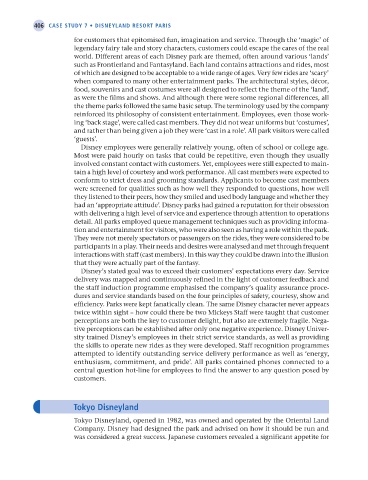Page 431 - Operations Strategy
P. 431
406 case study 7 • disneyland ResoRt PaRis
for customers that epitomised fun, imagination and service. Through the ‘magic’ of
legendary fairy tale and story characters, customers could escape the cares of the real
world. Different areas of each Disney park are themed, often around various ‘lands’
such as Frontierland and Fantasyland. Each land contains attractions and rides, most
of which are designed to be acceptable to a wide range of ages. Very few rides are ‘scary’
when compared to many other entertainment parks. The architectural styles, décor,
food, souvenirs and cast costumes were all designed to reflect the theme of the ‘land’,
as were the films and shows. And although there were some regional differences, all
the theme parks followed the same basic setup. The terminology used by the company
reinforced its philosophy of consistent entertainment. Employees, even those work-
ing ‘back stage’, were called cast members. They did not wear uniforms but ‘costumes’,
and rather than being given a job they were ‘cast in a role’. All park visitors were called
‘guests’.
Disney employees were generally relatively young, often of school or college age.
Most were paid hourly on tasks that could be repetitive, even though they usually
involved constant contact with customers. Yet, employees were still expected to main-
tain a high level of courtesy and work performance. All cast members were expected to
conform to strict dress and grooming standards. Applicants to become cast members
were screened for qualities such as how well they responded to questions, how well
they listened to their peers, how they smiled and used body language and whether they
had an ‘appropriate attitude’. Disney parks had gained a reputation for their obsession
with delivering a high level of service and experience through attention to operations
detail. All parks employed queue management techniques such as providing informa-
tion and entertainment for visitors, who were also seen as having a role within the park.
They were not merely spectators or passengers on the rides, they were considered to be
participants in a play. Their needs and desires were analysed and met through frequent
interactions with staff (cast members). In this way they could be drawn into the illusion
that they were actually part of the fantasy.
Disney’s stated goal was to exceed their customers’ expectations every day. Service
delivery was mapped and continuously refined in the light of customer feedback and
the staff induction programme emphasised the company’s quality assurance proce-
dures and service standards based on the four principles of safety, courtesy, show and
efficiency. Parks were kept fanatically clean. The same Disney character never appears
twice within sight – how could there be two Mickeys Staff were taught that customer
perceptions are both the key to customer delight, but also are extremely fragile. Nega-
tive perceptions can be established after only one negative experience. Disney Univer-
sity trained Disney’s employees in their strict service standards, as well as providing
the skills to operate new rides as they were developed. Staff recognition programmes
attempted to identify outstanding service delivery performance as well as ‘energy,
enthusiasm, commitment, and pride’. All parks contained phones connected to a
central question hot-line for employees to find the answer to any question posed by
customers.
Tokyo Disneyland
Tokyo Disneyland, opened in 1982, was owned and operated by the Oriental Land
Company. Disney had designed the park and advised on how it should be run and
was considered a great success. Japanese customers revealed a significant appetite for
Z07 Operations Strategy 62492.indd 406 02/03/2017 13:45

